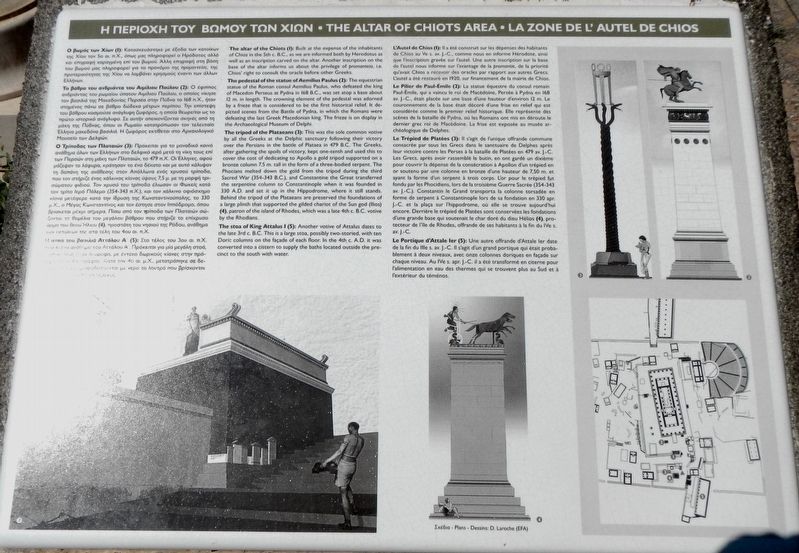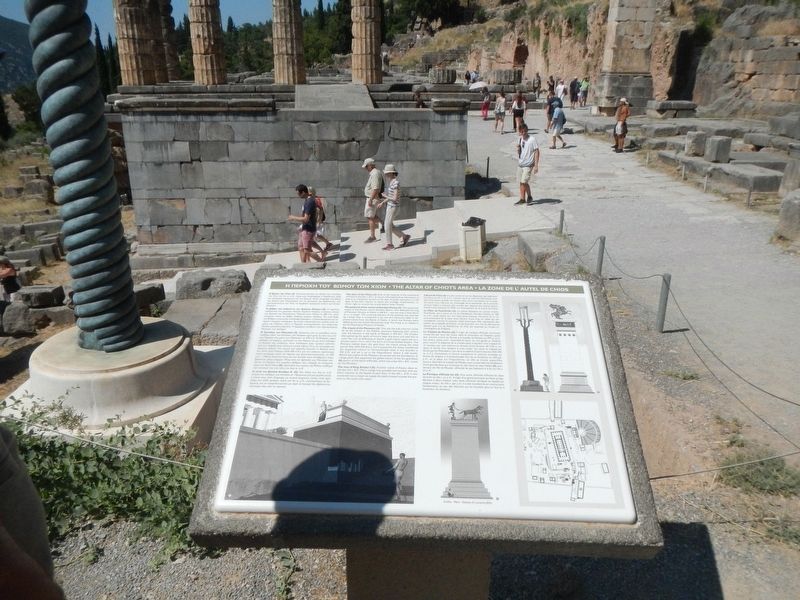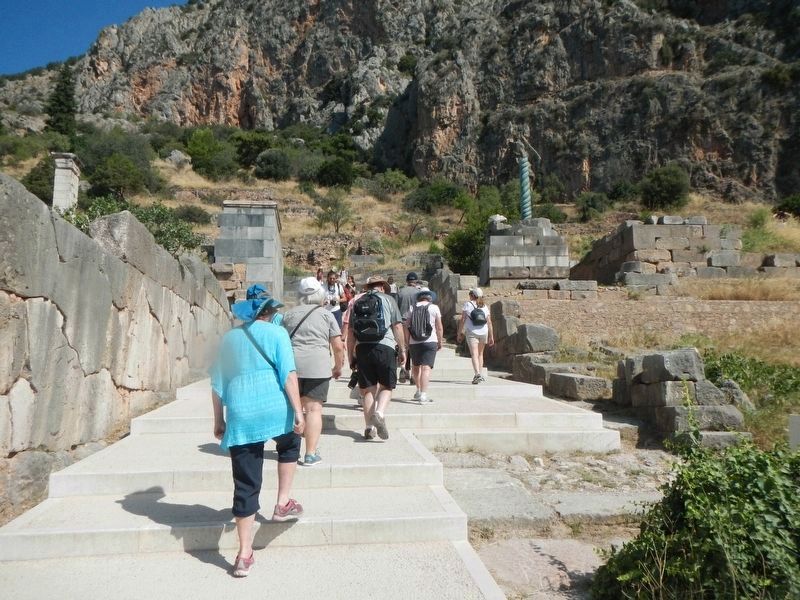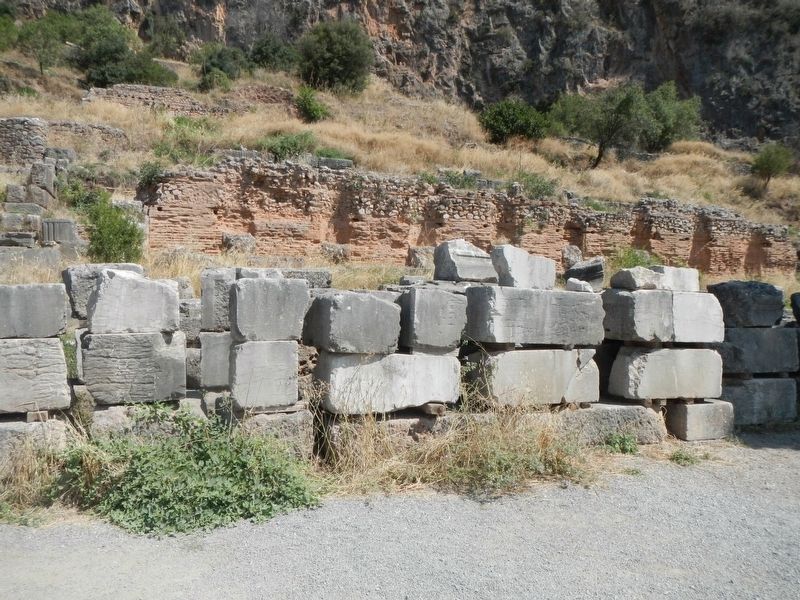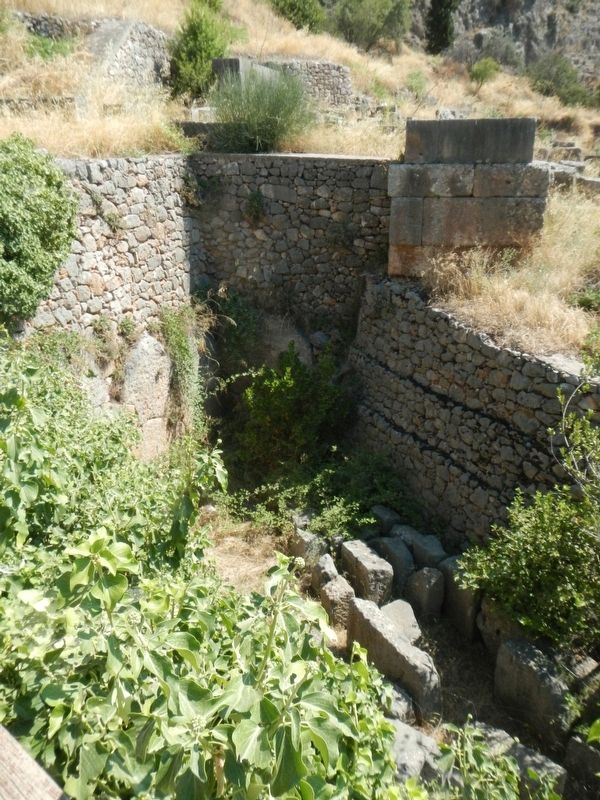Delfi in Phocis, Thessaly and Central Greece, Greece — Ελλάδα (Southeastern Europe, Balkan Peninsula)
The Altar of Chiots Area
H ΠEPIOXH TOY BΩMOY TΩN XIΩN
— La Zone de l'Autel de Chios —
English:
The altar of the Chiots (1): Built at the expense of the inhabitants of Chios in the 5th c. B.C., as we are informed both by Herodotus as well as an inscription carved on the altar. Another inscription on the base of the altar informs us about the privilege of promanteia i.e. Chios' right to consult the oracle before other Greeks.
The pedestal of the statue of Aemilius Paulus (2): The equestrian statue of the Roman consul Aemilius Paulus, who defeated the king of Macedon Perseus at Pydna in 168 B.C., was set atop a base about 12 m. in length. The crowning element of the pedestal was adorned by a frieze that is considered to be the first historical relief. It depicted scenes from the Battle of Pydna, in which the Romans were defeating the last Greek Macedonian king. The frieze is on display in the Archaeological Museum of Delphi.
The tripod of the Plataeans (3): This was the sole common votive by all the Greeks at the Delphi sanctuary following their victory over the Persians in the battle of Plataea in 479 B.C. The Greeks, after gathering the spoils of victory, kept one-tenth and used this to cover the cost of dedicating to Apollo a gold tripod supported on a bronze column 7.5 m. tall in the form of a three-bodied serpent. The Phocians melted down the gold from the tripod during the third Sacred War (354-343 B.C.), and Constantine the Great transferred the serpent column to Constantinople where it still stands. Behind the tripod of the Plataeans are preserved the foundations of a large plinth that supported the gilded chariot of the Sun god (Ilios) (4), patron of the island of Rhodes, which was a late 4th c. B.C. votive by the Rhodians.
The stoa of King Attalus I (5): Another votive of Attalus dates to the late 3rd c. B.C. This is a large stoa, possibly two-storied, with ten Doric column of the façade of each floor. In the 4th c. A.D. it was converted into a cistern to supply the baths located outside the precinct to the south with water.
Erected by Greek Ministry of Culture and Sports.
Topics. This historical marker is listed in these topic lists: Architecture • Churches & Religion • Man-Made Features.
Location. 38° 28.959′ N, 22° 30.101′ E. Marker is in Delfi, Thessaly and Central Greece, in Phocis. Marker can be reached from Ethniki Odos
Livadias Amfissas (Route EO 48), on the left when traveling east. Touch for map. Marker is in this post office area: Delfi, Thessaly and Central Greece 330 54, Greece. Touch for directions.
Other nearby markers. At least 8 other markers are within walking distance of this marker. The Temple of Apollo (a few steps from this marker); The Theater District (within shouting distance of this marker); The Halos (within shouting distance of this marker); Monuments of the Sacred Way (about 90 meters away, measured in a direct line); The Roman Agora (about 120 meters away); The (Delphi) Theatre (about 120 meters away); The Navel (about 120 meters away); The Treasury of the Sikyonians and Siphnians (about 120 meters away). Touch for a list and map of all markers in Delfi.
Related marker. Click here for another marker that is related to this marker. The Serpent Column in Istanbul
Credits. This page was last revised on March 21, 2022. It was originally submitted on November 16, 2018, by Barry Swackhamer of Brentwood, California. This page has been viewed 406 times since then and 42 times this year. Photos: 1, 2, 3, 4, 5. submitted on November 16, 2018, by Barry Swackhamer of Brentwood, California.
